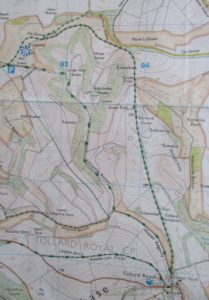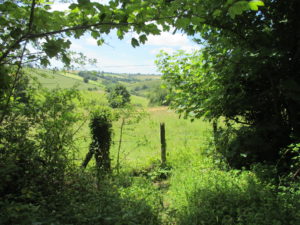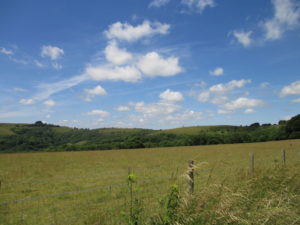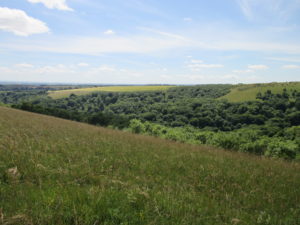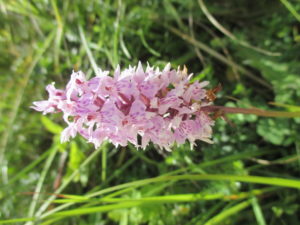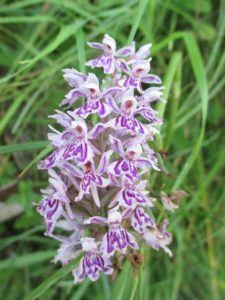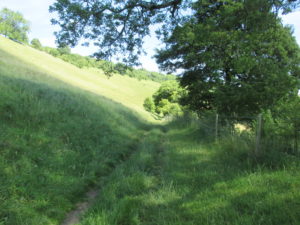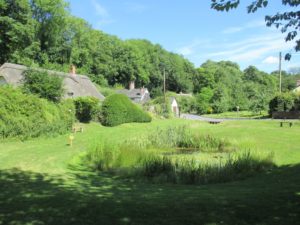Yesterday was a glorious summer’s day, and we went on a walk we’ve done a couple of times before, on byways and footpaths through the grounds of the Ashcombe Estate, near Tollard Royal in south Wiltshire. Ashcombe House was once the home of Sir Cecil Beaton, and he wrote a wonderful book about his life there. Click on photos to enlarge.
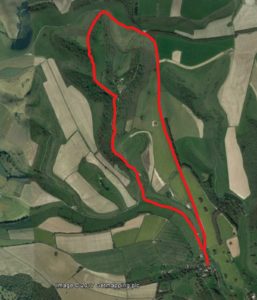
Google Earth image with route marked. We started at Tollard Royal at the bottom of the image and walked the route anti-clockwise direction, going up the straight byway at the start of the walk.
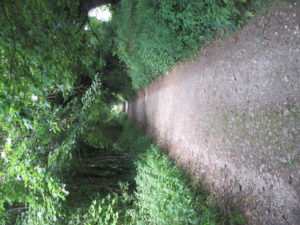
Going up the long straight byway. A byway is open to all traffic: we met a couple of cheery off-road motorbikers.
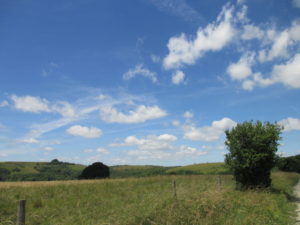
The path is still climbing, and on the left and centre you can see the tops of the wooded coombes in which Ashcombe House nestles.
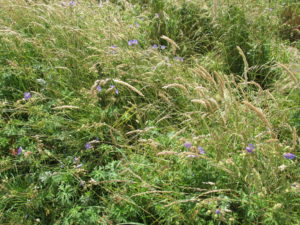
Lovely meadow cranesbill (Geranium pratense). It’s a much more vivid blue than this – the colour never comes out right in my photos.
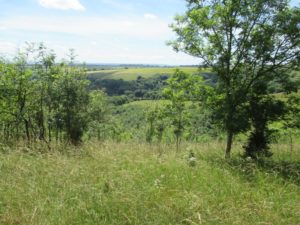
If you just squint you can see a part of the roof and dormer windows of Ashcombe House in the centre of the photo, surrounded by the woods. It is in the most wonderfully secluded spot.
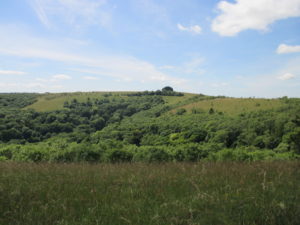
Not that you’ll be able to spot them, but there are two red kites (Milvus milvus) in this photo. The red kite has only colonised this area in the last 15 years or so.
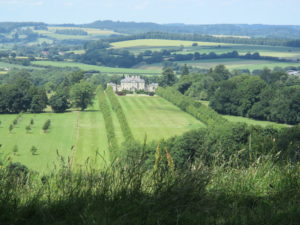
Ferne House, just to the north of the Ashcombe Estate, with its double avenue of trees. Despite looking like it has sat in its grounds for centuries, this mansion was built in 2001 for Lord Rothermere. It was designed in a Palladian style by architect Quinlan Terry.
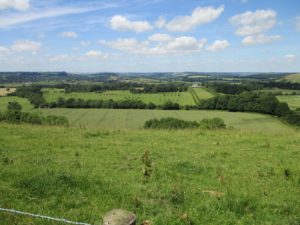
Ferne House and grounds. I’m fascinated by the groups of trees that have been planted – squares, circles, crosses, triangles and even what might be a love heart! This is the highest point of the walk, and is only a few metres lower than Win Green, the nearby highest ground with a trig point and fabulous vistas over south Wiltshire and north Dorset.
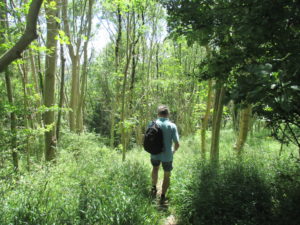
Starting the steep walk down through the woods to Ashcombe Bottom. You can see here how Ashcombe got its name – valley of the ashes. There were also some beautiful beech trees in the woods, and luckily no sign of the dreaded ash die-back disease we’ve been hearing so much about recently.
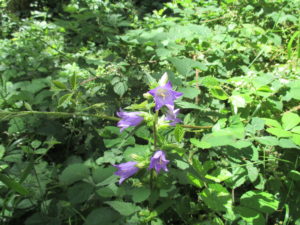
It was a lovely surprise to see so many nettle-leaved bellflowers (Campanula trachelium) in the woods. The ransoms/wild garlic (Allium ursinum) leaves were dying off but the aroma was still pungent – delicious!
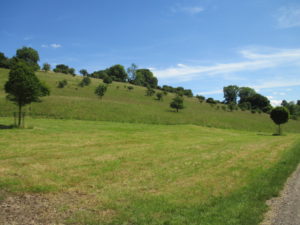
Walking down Ashcombe Bottom. Along with the estate trees (with their stock-proof cages) it was lovely to see the hawthorn bushes (Crataegus monogyna) on the hillside: such a classic part of chalk downland life.
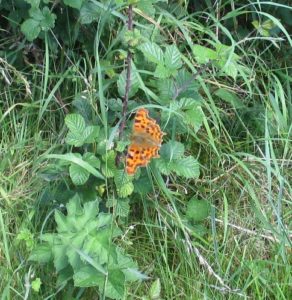
A rather crappy photo of a gorgeous comma butterfly (Polygonia c-album) with its ragged wing edges.
Such a lovely walk: we saw some many wildflowers and grasses, including goatsbeard (Tragopogon pratensis), quaking grass (Briza media), pyramidal orchids (Anacamptis pyramidalis), common spotted orchids (Dactylorhiza fuchsii), common valerian (Valeriana officinalis), field scabious (Knautia arvensis), nettle-leaved bellflower (Campanula trachelium), meadow cranesbill (Geranium pratense), chalk milkwort (Polygala calcarea), lady’s bedstraw (Galium verum), wild carrot (Daucus carota), greater knapweed (Centaurea scabiosa), hedge bedstraw (Galium mollugo) and many others. The one plant I expected to see and did not was the harebell (Campanula rotundifolia), an absolute classic flower of chalk downlands.
We saw ten butterfly species: small tortoiseshell (Aglais urticae), small white (Pieris rapae), grizzled skipper (Pyrgus malvae), marbled white (Melanargia galathea), peacock (Aglais io), red admiral (Vanessa atalanta), comma (Polygonia c-album), meadow brown (Maniola jurtina), speckled wood (Pararge aegeria) and gatekeeper (Pyronia tythonus). We weren’t really looking out for birds so much, but saw red kites and buzzards, plus a female blackcap and heard a beautiful male blackbird’s song in the woods. A blue damselfly settled on the drive in front of us as we walked along Ashcombe Bottom. It’s a wonderful walk in beautiful countryside, and we shall be doing it again before too long.
